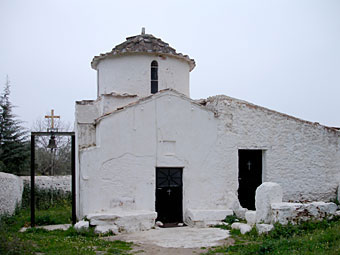
 |
 |
 |
 |
Type: Aisleless, Cross-in-Square
Date: 12th century
Description:
The church is situated in Paiania, in the southwest of the village, in the position Chalidou. It’s an aisleless, cross-in-square church and preserves wall paintings of three different eras. Initially it was dated to the years of the Turkish domination due to the small windows and other facts based on which monuments are dated. However, when it was established that the wall paintings of the dome dated to the Komnenian era, the church was re-dated. Nevertheless, during its reappraisal no characteristic features of the Komnenian period were evident. Therefore, no one can eliminate the fact that it had been built long before it was frescoed. But, if, according to Professor Bouras, it is contemporary to its wall paintings, we come across another building of no special architectural value that didn’t follow the usual trend.
On the top of the high dome Pantokrator is portrayed inside a circle with a halo inscribed with a cross. He blesses with an austere look. We come across this type in many middle Byzantine domes. Pantokrator is surrounded by the Virgin Mary on a medal, the Preparation of the throne and interposed angels’ orders. The presence of the Virgin Mary in the wall painting symbolizes the incarnation of Logos (the Word). The Preparation of the throne symbolizes the glory of the Day of Judgment. The angels’ orders signify that the Word of Pantokrator rules the universe. All these reflect the iconographic tradition of the 12th century, which is the attribution of honor to the master of the universe. Doula Mourikis dated the wall paintings of Chalidou to the last quarter of the 12th century. The style of the dome places them to the late Komnenian painting trend. They are preserved fragmentarily and in bad condition. However, they offer important information on the artistic production in this distant area of the end of the 12th century, and therefore they are valuable.
Bouras C.-Andreadi R.-Kaloyeropoulou A.m,Churches of Attica, Athens 1970, p.233, plan XXII, illustration 194-203




